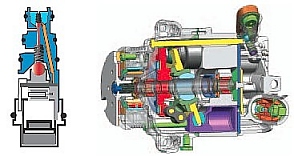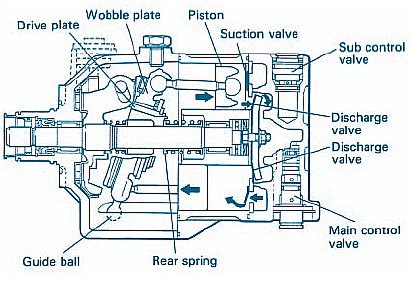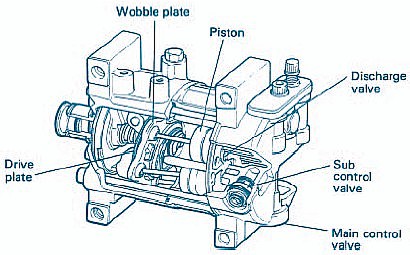Depending on the design, the
pistons are driven by a wobble plate or a swash plate. In a wobble plate
compressor, the pistons are connected to the plate with short push rods.
An angled yoke on the driveshaft causes the plate to wobble when the
shaft rotates, driving the pistons back and forth in their bores.
In a swash plate compressor,
the plate itself rotates with the driveshaft. A bearing in the bottom of
each piston “clamps” around the edge and rides on either face of the swash
plate.
The plate is set at an angle
to the shaft, so as it rotates, the pistons are forced back and forth in
their bores.
The angle of the wobble
plate or the swash plate determines the length of the piston stroke. In a
variable displacement compressor, that angle can be changed, which changes
the length of the pistons’
stroke and, therefore, the
amount of refrigerant displaced on each stroke. The angle is adjusted
using springs and linkage that move lengthwise along the driveshaft, and
it’s controlled with refrigerant pressure in the compressor housing. When
housing pressure is increased, the pressure exerted on the back side of the pistons
keeps them “higher” in their bores and closer to the cylinder head. This
shortens the stroke, reducing displacement.
VARIABLE DISPLACEMENT
A/C COMPRESSOR

This electric control
valve (left) includes the pressure sensor in the valve assembly, but
the sensor could be mounted anywhere in the system. The Delphi
compressor (right) uses an adjustable swash plate to change piston
displacement.
When housing pressure is
reduced, a spring pushes the adjusting linkage away from the cylinder
head, increasing plate angle and lengthening the piston
stroke to increase
displacement. Housing pressure is adjusted using a control valve with
ports and passages that connect it to the suction (low-side) and discharge
(high-side) chambers of the compressor head. Two different types of
control valves are used. The traditional mechanical
valve has a precision
pressure sensitive diaphragm that senses low side pressure. When the cabin
temperature is warm, evaporator temperature increases, which increases low
side pressure. This pushes on the diaphragm, opening a port that vents a
little bit of housing pressure to the suction side. Reducing housing
pressure increases piston stroke, which increases refrigerant flow volume
through the system. As evaporator temperature decreases, so does low side
pressure. The diaphragm “rebounds” to close the low-side vent port and at
the same time open a port that admits high-side pressure into the housing.
This reduces piston stroke and, therefore, refrigerant flow volume.
Remember, changing flow volume doesn’t necessarily change pressure.
Around 2001, DENSO was first to replace the diaphragm valve with a
solenoid valve and add temperature and pressure sensors in the refrigerant
system. This allows a computer to control the valve and adjust compressor
displacement to control evaporator temperature, rather than using
evaporator
temperature to control
displacement. Today almost all manufacturers offer electronically
controlled variable displacement compressors, and some applications have
no clutch, meaning the compressor runs whenever the engine is running.
Most vehicles already operate the compressor any time the windshield
defogger is turned on, even in winter. The electronic displacement control
valve makes it easier to run the compressor continuously because
displacement can be reduced closer to zero than with a mechanical valve.
Continuous operation keeps seals lubricated, minimizes oil pooling and prevents other kinds of
damage that result from long periods of inactivity.
6-CA COMPRESSOR

A cut-away of a Nippondenso 6-CA
compressor. When housing pressure is low, the rear spring increases
drive plate/wobble plate angle, thus increasing displacement.

Also, with the A/C system
controlled according to cabin temperature demand as opposed to evaporator
temperature demand, the need to reheat air that’s been cooled below the
requested temperature is eliminated. Ultimately the electronically
controlled variable displacement compressor puts less load on the engine,
improving fuel economy by as much as one-half mile per gallon. And of
course, the driver will never feel the A/C clutch cycling or the idle
speed surge that sometimes accompanies it.
The mechanical control valve
is inexpensive and reliable, but it doesn’t provide the same control as
the electronic valve. Eventually most A/C systems will use an
electronically controlled variable displacement compressor.